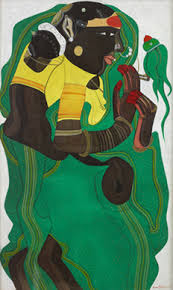 |
| Neti, Neti by Surendran Nair (Oil on canvas) |
The Bhagavad Gita is considered by many as a turning point that demarcate their lifespan as period before Gita and after it. For people who seek the higher purpose of existence, the Gita provides a satisfactory answer and for lesser mortals it forwards a workable strategy which can negotiate the rough terrains with ease. You don’t feel like stepping on the gas on freeways either. Unlike the Upanishads which goes about cancelling each possibility by neti… neti…(not this, not this), Bhagavad Gita singles out the only possibility and says asi… (this is). However, the high point that really impressed me is the respect it confers on the reader and his/her freedom of choice. Towards the end of the last Chapter, it says
Idi they Jnanamakyatam Guhyat Guhyataram Maya
Vimrishaitadaseshana Yadechasi Tada Kuru
(sloka 63, Chapter 18)
this can roughly be translated as
You have been advised the most esoteric knowledge and its various ways. Apply your mind and see for yourself whether it is agreeable. Thereafter do what you feel like.
 |
| Baiju Parthan |
This is a very bold stand. Even the most celebrated leftist icons have not dared to unleash their readers so that they can roam free into undesirable philosophies. True that all leftist icons have urged their followers to continuously put them under scanner. There is the demand for continuous update too. (swadhyaya in Sanskrit).
Here is a sampler.
“Your mind is like a fertile field. Plough it properly. Always keep it free from weeds and pests. Even a grain from the beak of a sparrow-in-flight, if dropped on the field by chance, should sprout.”
This imagery is beautiful. In comparison, one gets impressed by two greater imageries contained in the Gita. That of the chariot drawn by five white horses. The analogy is to human body as chariot, intellect as charioteer, sensory organs as horses, mind as rein and soul as the chariot-rider. The horses are bound to go wayward after various types of pleasures and they should be subjected to rigorous control. Can you put out a fire by pouring more and more ghee on it? You get burnt out in the end. One should get convinced that pleasure is a very poor substitute for happiness, a state of mind in which we feel complete and full without any props. Happiness is our natural state of being which can be regained by shedding both craving as well as aversion. Ego-centric desires should be neutralised first. One no longer harbours any “Us and Them” feeling and the resultant “PLU Syndrome”.
There is yet another imagery, that of an upside-down peepul tree in Chapter 15 (slokas 1 & 2)
Urdhwamoolamadhasakhamaswadham Prahuravyayam
Chandamsi Yasya Parnani Yastam Veda Sa Vedavit
The Universe is analogous to a peepul tree whose roots are on top, branches beneath and grows non-stop. The tree gets irrigated by the water (Trishna, i.e., egocentric desires). The leaves quiver in the breeze of sakama karma (self-oriented projects). Activities like Yajna (selfless endeavours for greater common good), dana (act of covert donation), tapas (pointed and all-out effort) etc. are its flowers. Happiness and sorrow are its fruits. The cacophony arising out of the melee – joy as well as despair – cries, laughter, shouts, sobs, shrieks etc. gives the tree its identifying label. One cannot have the full vision of the tree watching from the ground or from any other altitude. Even bird’s eye-view will not give the correct perspective. Normal vision is helpless to find where the tree is rooted.
Asanga Sastrena Dhridena Chhitwa
The grotesque tree should be felled using a sturdy hack-saw of nissangatwa which is in essence, Selflessness itself.
The Bhagavad Gita, however, has its stumbling blocks too. Thrice I met with a dead-end. Fortunately I could take a detour to continue. The riddles part of the book lies here, perhaps. Sure enough, for people with real intelligence, the riddles don’t exist at all. For plebeians, it does. I was baffled first by the “ma faleshu karma” theory (action without the cutting edge), then by the “Ahimsa” that’s different from what the Buddha or even Gandhiji propounded and finally by the “Guna-Varna” justification (deprivations by default). I have a feeling that one has to re-read the text to grasp what is really intended.
Your comments are welcome.
 |
| "Forty Winks" water colour on paper by Surendran Nair (1997) |
